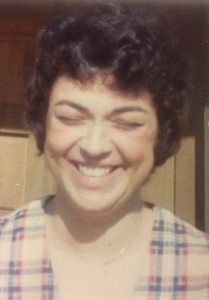Cushing’s: A perspective nearly 40 years later

With Cushing’s in 1978
My experience with Cushing’s has spanned 40 years, from the onset of seemingly innocuous symptoms, through the frightening feeling of losing control as this disease ravaged my body, and finally to diagnosis and treatment.
In hindsight, my first symptom was the cessation of my menstrual cycle around age 22; a doctor prescribed “the pill” to stimulate my natural cycle. I didn’t know that the pill simply masked the fact that I wasn’t ovulating at all. Meanwhile, I began growing hair on my upper lip, so much so that I had electrolysis treatments, removing the manifestation of a telltale symptom of Cushing’s. I had not gained weight, but I could not sleep and was plagued with constant restlessness.
After 5 years of marriage, I stopped taking birth control pills but did not begin a menstrual cycle. One doctor mentioned “overactive adrenal glands” casually, but never tested me; he even said the condition would likely correct itself during pregnancy. I thought this “overactivity” might also be the cause of my sleep issues. After several diagnostic procedures and aided by fertility drugs, I was pregnant and delivered my first child. I was over the moon, and with continued fertility treatments, I got pregnant again.
My second pregnancy brought sorrow as well as joy. I delivered twins 7 weeks early, and one lived only 2 days. In 1975—prior to ultrasound—no one knew there were twins. The fertility drugs were likely responsible for twins; I will never know if Cushing’s played a role in the loss of one of them. The next 3 years were a blur, caring for 2 boys less than 2 years apart, not to mention that my second was premature and required feedings more often for the first 6 months. My focus on their needs meant a lack of attention to myself and the growing symptoms of my disease.
By age 2, my younger son was healthy and on par with other children. I was 33 and began to take measure of my own health. I was 25 pounds overweight, my face was round, my skin darkening and blotchy, and bruises were common. I had begun to grow hair under my chin and on my belly and I quite simply didn’t look the same. I attributed the weight gain to my pregnancies. The bruising—I was sure—came from playing with my active children. The facial hair and skin issues, I excused because of my heritage; my father was olive skinned with a dark, heavy beard. Besides, I told myself, I’m over 30!
I joined a gym—called a “Health Club” in the 1970s—and there I experienced the dramatic event that led to my diagnosis. I was using the stationary bike and after slowing to get off, the weighted pedals continued around. One brushed my calf and though I wasn’t hit hard, my leg began to hurt. In the dressing room, I removed my tights (which were not torn) and saw that my leg had been cut to the bone. The emergency room doctor asked if I were diabetic or a drug user; he said the skin on my legs was thin and fragile, like that of an 80- year-old. Thus began several months of doctor visits with primary, internist and finally, because of poor healing and a cavern in my leg, a plastic surgeon. It was this man, Dr. Jones, who suspected Cushing’s. Dr. Jones repaired my leg and during my hospital stay, I was seen by an endocrinologist. Preliminary tests revealed that Dr. Jones was correct. It took another 5 months to discover the reason for the disease.
Additional tests included an awful venal probe, radioactive dye in my veins, X-rays and even the latest diagnostic tool, a CAT scan. These ruled out some causes but were inconclusive as to the exact cause. My doctors could not find a pituitary tumor, so transsphenoidal surgery was not suggested. They could not rule out an adrenal adenoma or a tumor elsewhere in the endocrine system. Therefore, they recommended a bilateral adrenalectomy. I was told it was a serious operation that could affect my life adversely and possibly even shorten it. Of course, living with untreated Cushing’s would have had the same effect, and I was eager to feel and look better no matter how much life I had left.
I had surgery in October 1978, spending 3 days in intensive care and 4 more in the hospital. I was in great pain but so elated to have it done! Recovery was slower than I would have liked and during those first few years post-surgery I had a few hospital visits due to adrenal crisis until my body adjusted. I learned to increase the hydrocortisone during stressful times when the body would normally do so.
I had some hard days, no doubt, but I had those little boys who needed me. After the interest (from friends and family) in my condition wore off and I began to look “normal,” life went back to the same. I didn’t have time to dwell on myself and since neither I nor my primary doctors knew another Cushing’s patient, I simply expected to feel better and I certainly did. Years later, doctors did indeed find a pituitary microadenoma by MRI. Luckily, it has caused no further issues.
I am now in my 70s and still grateful for Dr. Jones. I don’t blame doctors who didn’t recognize my symptoms; Cushing’s is not an easy diagnosis now, and doctors had a smaller body of knowledge when I was diagnosed. I am glad for this forum, for the chance to share my story and perhaps to impart some hope for those people, people as young as I was, that there is life after this disease—a nice long life!
Member: 163207
State: Arizona
Newsletter: Spring, 2017



